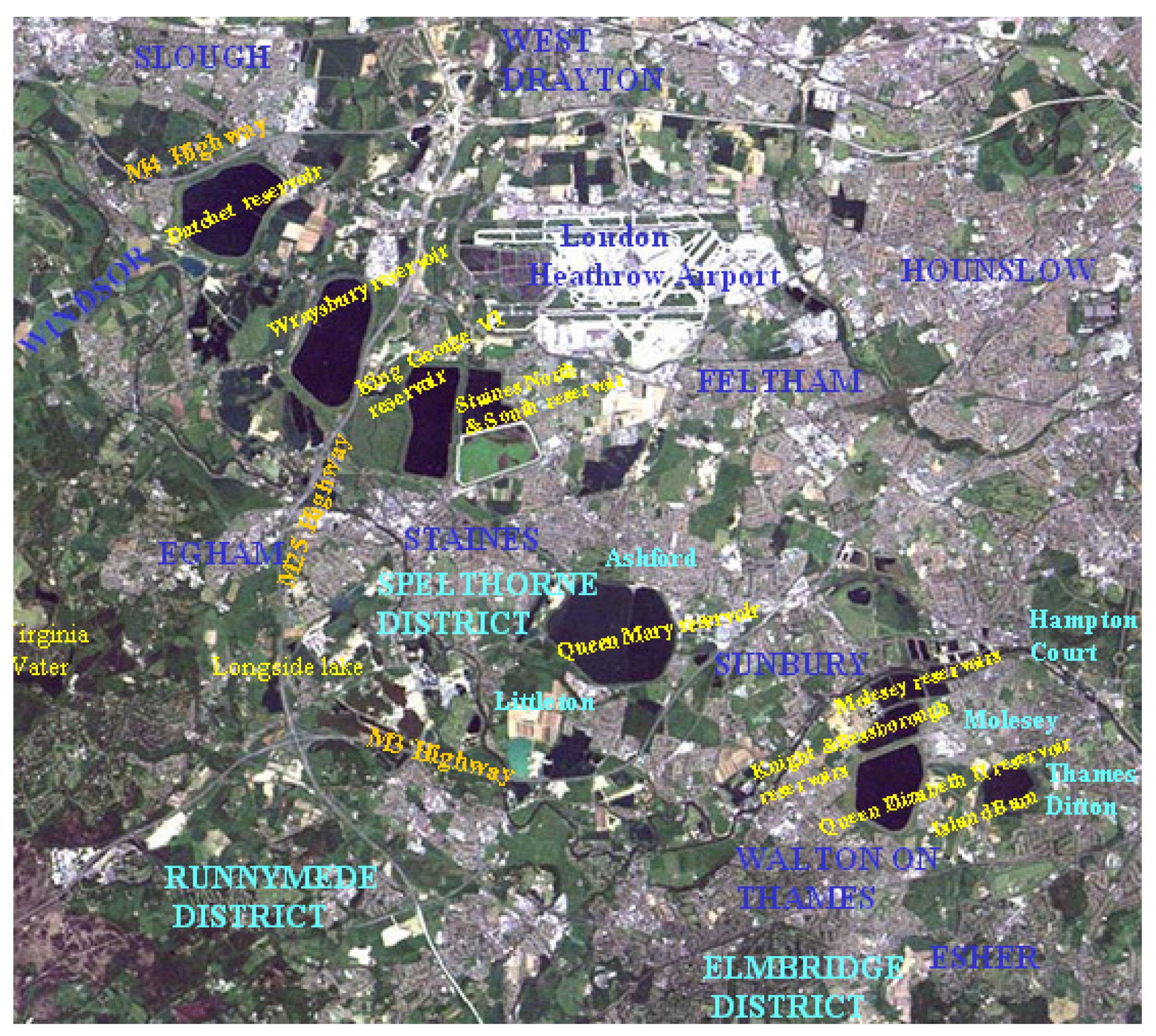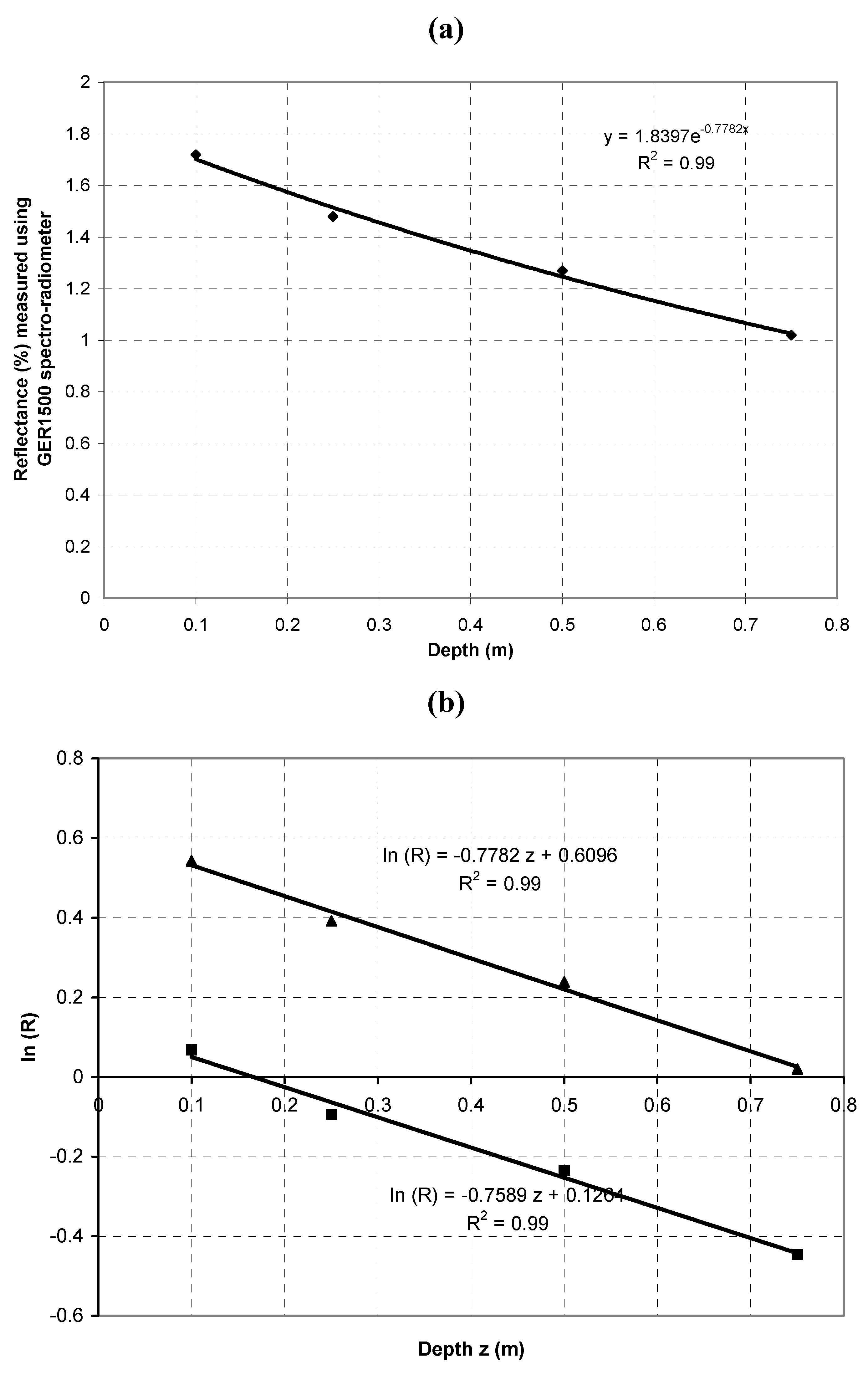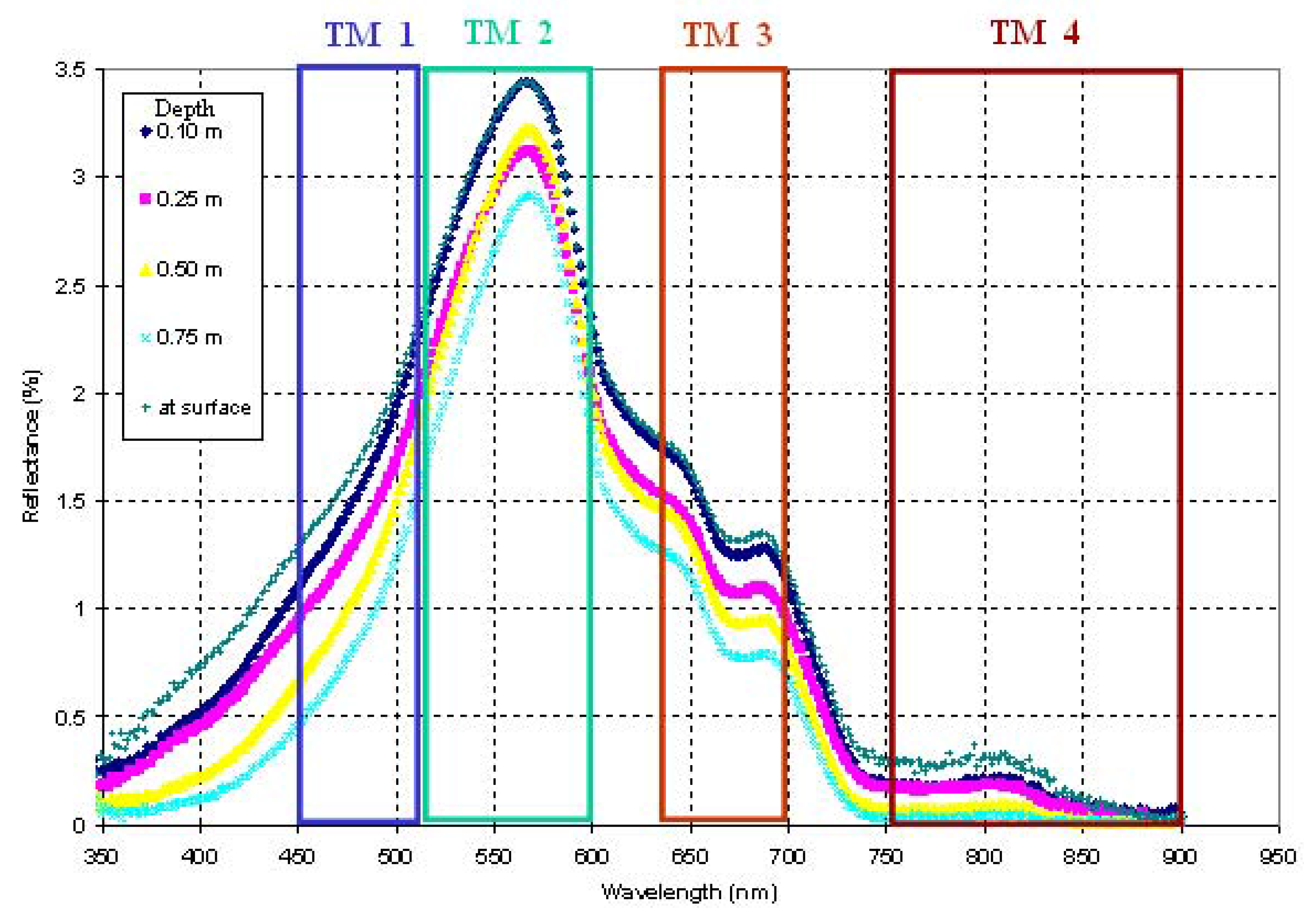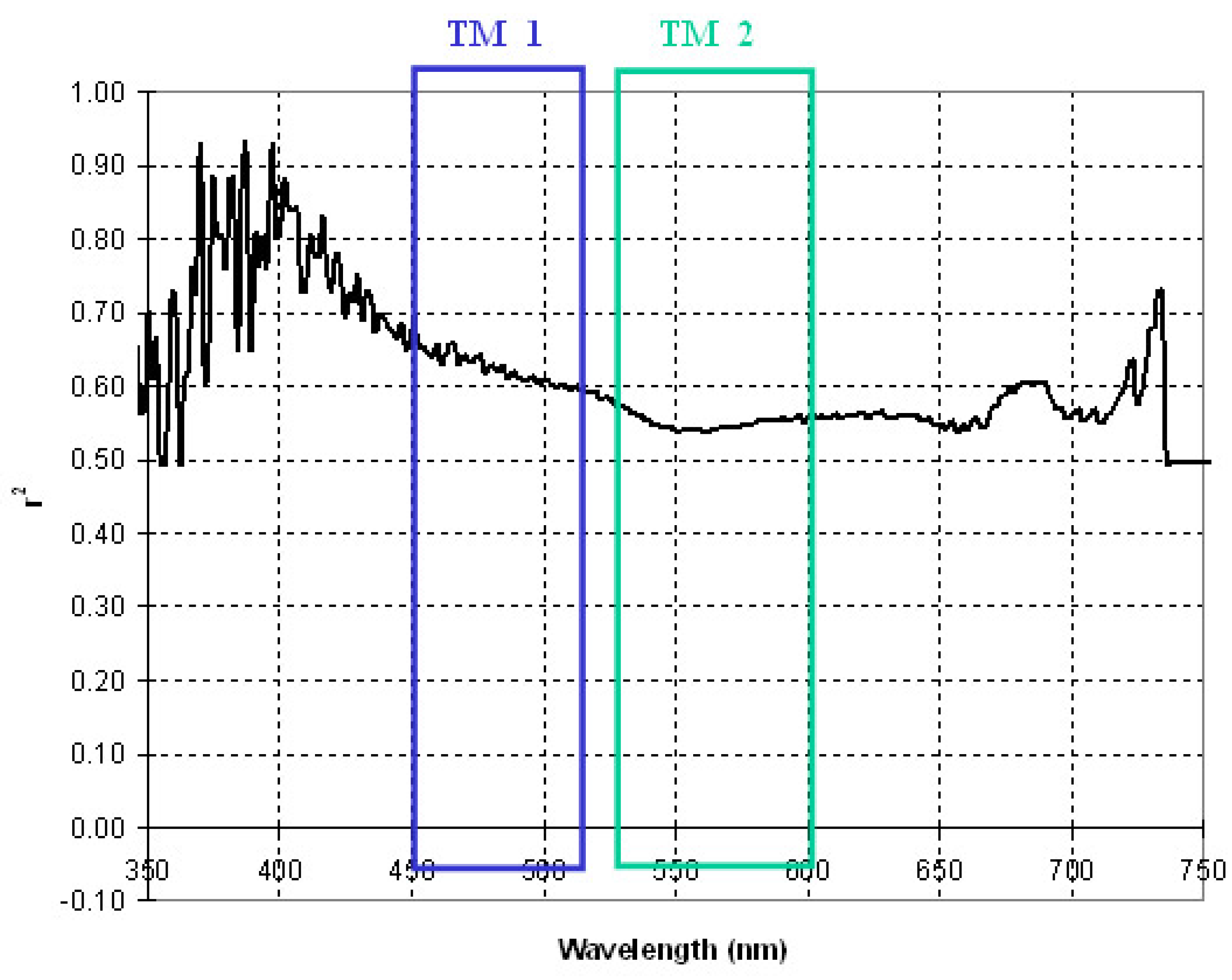Field Spectroscopy for Assisting Water Quality Monitoring and Assessment in Water Treatment Reservoirs Using Atmospheric Corrected Satellite Remotely Sensed Imagery
Abstract
:1. Introduction
- to identify the spectral region in which chlorophyll-a (Chl-a) and particulate organic carbon (POC) can be retrieved using field spectroscopy;
- to develop a novel methodology to measure the reflectance at the water surface using field spectroscopy;
- to develop regression models based upon the spectral features to monitor the water quality in large water treatment reservoirs in West London using satellite imagery acquired during water sampling;
- to use such regression models for further testing using atmospheric corrected satellite imagery.
2. Materials and Methods
2.1. Study Area

2.2. Resources
2.3. Spectro-Radiometric Measurements
- Rz is the reflectance at a depth z
- R0 is the reflectance at zero depth
- K is the irradiance attenuation coefficient or vertical extinction coefficient.


| Reservoir | Date | Chl-a (μg/L) | POC (μg/L) | In-band reflectance % | |||
|---|---|---|---|---|---|---|---|
| TM1 | TM 2 | TM 3 | TM 4 | ||||
| Queen Mary | 23-9-1998 | 12.40 | 861 | 2.61 | 4.26 | 2.32 | 0.19 |
| Wraysbury | 23-9-1998 | 5.58 | 610 | 0.50 | 0.79 | 0.33 | 0.02 |
| Datchet | 23-9-1998 | 11.41 | 795 | 0.58 | 0.86 | 0.38 | 0.04 |
| Queen Mary | 12-10-1998 | 3.70 | 404 | 0.83 | 1.69 | 0.68 | 0.016 |
| Queen Elizabeth II | 12-10-1998 | 3.70 | 404 | 2.87 | 4.79 | 2.94 | 0.27 |
| King George VI | 12-10-1998 | 9.43 | 521 | 1.02 | 1.55 | 0.74 | 0.06 |
| Queen Mary | 14-12-1998 | 1.72 | 266 | 1.88 | 3.28 | 1.96 | 0.08 |
2.4. Water Quality
- ▪
- algal biomass (chlorophyll-a and POC),
- ▪
- concentration of suspended matter (SS, turbidity)
- ▪
- organic matter (BOD)
- ▪
- dissolved oxygen (DO)
2.5. Methodology
- ▪
- Carry out spectro-radiometric measurements as described in Section 2.3
- ▪
- Obtain water samples in situ near the sampling stations of each reservoir acquired concurrently with the spectro-radiometric measurements.
- ▪
- In order to identify possible regions of the spectrum in which the water quality parameters could be identified, the first step was to investigate how the water quality parameters were related to each other and to perform a correlation analysis.
- ▪
- Provide categorization of the water quality variables into groups based on their properties.
- ▪
- Determine the possible predictors for both chlorophyll-a and POC using a linear regression analysis between the mean reflectance values across the spectrum measured by the GER1500 field spectro-radiometer and the concentrations of chlorophyll-a (μg/L) and POC (μg/L).
- ▪
- The wavelength in which a highest correlation coefficient obtained by the linear regression analysis applied in the previous step corresponds to the optimal wavelength that chl-a and POC can be retrieved. Apply the developed regression models to archived and recent Landsat TM/ETM+ image acquisitions for further calibration and validation after applying the darkest pixel atmospheric correction algorithm.
2.6. Atmospheric Correction
- ρtg is the target reflectance at the ground
- Lds is the dark object radiance at the sensor
- Lts is the target radiance at the sensor,
- = E0 × d is the solar irradiance at the top of the atmosphere corrected for earth-sun distance variation i.e., E0, d
- θ0 is the solar zenith angle
3. Results and Discussion
| Chlorophyll-a | POC | ||
|---|---|---|---|
| Wavelength (nm) | r2 | Wavelength (nm) | r2 |
| 370.4 | 0.86 | 370.4 | 0.93 |
| 375.07 | 0.79 | 375.07 | 0.88 |
| 381.34 | 0.79 | 381.34 | 0.88 |
| 382.92 | 0.79 | 382.92 | 0.88 |
| 386.09 | 0.79 | 386.09 | 0.99 |
| 387.68 | 0.86 | 387.68 | 0.93 |
| 397.27 | 0.86 | 397.27 | 0.93 |
| 402.11 | 0.79 | 402.11 | 0.93 |
| 416.75 | 0.83 | ||
- ◆
- for chlorophyll-a, 400–450 nm (with r2 0.80–0.60) and 730–735 (with r2 ≅ 0.60)
- ◆
- for POC, 400–530 nm (with r2 0.80–0.60) and 728–735 (with r2 ≅ 0.60).


- chl-a: Chlorophyll-a concentration in μg/L
- TM1 is the reflectance from Landsat-5 TM1 (after atmospheric correction)
- POC: Particulate organic carbon concentration in μg/L
- TM1 is the reflectance from Landsat-5 TM1 (after atmospheric correction)
4. Conclusions
- ▪
- for chlorophyll-a, TM band 1 (0.45–0.52 µm)
- ▪
- for POC, TM bands 1 (0.45–0.52 µm) and 2 (0.52–0.60 µm).
Acknowledgements
References
- Tyler, J.E.; Smith, R.C. In situ spectroscopy in ocean and lake waters. J. Opt. Soc. Am. 1965, 55, 800–805. [Google Scholar] [CrossRef]
- Tyler, J.E.; Smith, R.C. Spectro-radiometric characteristics of natural light under water. J. Opt. Soc. Am. 1967, 57, 595–601. [Google Scholar] [CrossRef]
- Blanchard, B.J.; Leamer, R.W. Spectral reflectance of water containing suspended sediment. In Proceedings of Symposium on Remote Sensing and Water Resources Management, Urbana, IL, USA, 11–14 June 1973; pp. 339–347.
- Jupp, D.L.B.; Kirk, J.T.; Harris, G.P. Detection, identification and mapping of cyanobacteria—Using remote sensing to measure the optical quality of turbid inland waters. Aust. J. Mar. Fresh Res. 1994, 45, 801–828. [Google Scholar] [CrossRef]
- Arenz, R.F. Reflectance and Absorption Spectrometry of Colorado Front Range Reservoirs. M.A. Thesis, Department of Environmental, Population, and Organismic Biology, University of Colorado, Population, Boulder, CO, USA, 1994. [Google Scholar]
- Arenz, R.F.; Lewis, W.M.; Saunders, J.F. Determination of chlorophyll and dissolved organic carbon from reflectance data for Colorado reservoirs. Int. J. Remote Sens. 1996, 17, 1547–1566. [Google Scholar] [CrossRef]
- Koponen, S.; Pulliainen, J.; Kallio, K.; Hallikainen, M. Lake water quality classification with airborne hyperspectral spectrometer and simulated MERIS data. Remote Sens. Environ. 2002, 79, 51–59. [Google Scholar] [CrossRef]
- Kallio, K.; Koponen, S.; Pulliainen, J. Feasibility of airborne imaging spectrometry for lake monitoring—A case study of spatial chlorophyll a distribution in two meso-eutrophic lakes. Int. J. Remote Sens. 2003, 24, 3771–3790. [Google Scholar] [CrossRef]
- Kallio, K.; Kutser, T.; Hannonen, T.; Kutser, T.; Koponen, S.; Pulliainen, J.; Vepsäläinen, J.; Pyhälahti, T. Retrieval of water quality variables from airborne spectrometry of various lake types in different seasons. Sci. Total Environ. 2001, 268, 59–77. [Google Scholar] [CrossRef]
- Hadjimitsis, D.G.; Clayton, C.R.I. Assessment of temporal variations of water quality in inland water bodies using atmospheric corrected remotely sensed image data. Environ. Monit. Assess. 2009, 159, 281–292. [Google Scholar] [CrossRef] [PubMed]
- Hadjimitsis, D.G.; Clayton, C.R.I.; Toulios, L. A new method for assessing the trophic state of large dams in Cyprus using satellite remotely sensed data. Water Environ. J. 2010, 24, 200–207. [Google Scholar] [CrossRef]
- Hadjimitsis, D.G.; Hadjimitsis, M.G.; Toulios, L.; Clayton, C.R.I. Use of space technology for assisting water quality assessment and monitoring of inland water bodies. Phys. Chem. Earth 2010, 35, 115–120. [Google Scholar] [CrossRef]
- Ramsey, E.W.; Jensen, J.R.; Mackey, H.; Gladden, J. Remote Sensing of water quality in active to inactive cooling water reservoirs. Int. J. Remote Sens. 1992, 11, 979–998. [Google Scholar] [CrossRef]
- Dekker, A.G. Detection of Optical Water Quality Parameters for Eutrophic Waters by High Resolution Remote Sensing. Ph.D. Thesis, Institute of Earth Sciences, Vrije Universiteit, Amsterdam, The Netherlands, 1993. [Google Scholar]
- Dekker, A.G.; Malthus, T.J.; Hoogenboom, H.J. The remote sensing of inland water quality. In Advances in Environmental Remote Sensing; Danson, F.M., Plummer, S.E., Eds.; John Wiley & Sons: Chichester, UK, 1995; pp. 123–142. [Google Scholar]
- Verdin, J.P. Monitoring water quality conditions in a large western reservoir with Landsat imagery. Photogramm. Eng. Remote Sens. 1985, 51, 343–353. [Google Scholar]
- Dewidar, K.; Khedr, A. Water quality assessment with simultaneous Landsat-5 TM at Manzala Lagoon Egypt. Hydrobiologia 2001, 457, 49–58. [Google Scholar] [CrossRef]
- He, W.; Chen, S.; Liu, X.; Chen, J. Water quality monitoring in a slightly-polluted inland water body through remote sensing—Case study of the Guanting Reservoir in Beijing, China, Front. Environ. Sci. Eng. 2008, 2, 163–171. [Google Scholar]
- Härmä, P.; Vepsäläinen, J.; Hannonen, T.; Pyhälahti, T.; Kämäri, J.; Kallio, K.; Eloheimo, K.; Koponen, S. Detection of water quality using simulated satellite data and semi-empirical algorithms in Finland. Sci. Total Environ. 2001, 268, 107–121. [Google Scholar] [CrossRef]
- Chen, Q.; Zhang, Y.; Hallikainen, M. Water quality monitoring using remote sensing in support of the EU water framework directive (WFD): A case study in the Gulf of Finland. Environ. Monit. Assess. 2007, 12, 157–166. [Google Scholar] [CrossRef] [PubMed]
- Pozdnyakov, D.; Shuchman, R.; Korosov, A.; Hatt, C. Operational algorithm for the retrieval of water quality in the Great Lakes. Remote Sens. Environ. 2005, 97, 352–370. [Google Scholar] [CrossRef]
- Hadjimitsis, D.G.; Hadjimitsis, M.G.; Clayton, C.R.I.; Clarke, B. Monitoring turbidity in Kourris Dam in Cyprus utilizing Landsat TM remotely sensed data. Water Resour. Manage. 2006, 20, 449–465. [Google Scholar] [CrossRef]
- Ormeci, C.; Sertel, E.; Sarikaya, O.O. Determination of chlorophyll-a amount in Golden Horn, Istanbul, Turkey using IKONOS and in situ data. Environ. Monit. Assess. 2008, 155, 83–90. [Google Scholar] [CrossRef] [PubMed]
- Becker, B.; Lusch, D.; Qi, J. Identifying optimal spectral bands from in situ measurements of Great Lakes coastal wetlands using second-derivative analysis. Remote Sens. Environ. 2005, 97, 238–248. [Google Scholar] [CrossRef]
- Hadjimitsis, D.G.; Clayton, C.R.I.; Hope, V.S. An assessment of the effectiveness of atmospheric correction algorithms through the remote sensing of some reservoirs. Int. J. Remote Sens. 2004, 25, 3651–3674. [Google Scholar] [CrossRef]
- Hadjimitsis, D.G. The Application of Atmospheric Correction Algorithms in the Satellite Remote Sensing of Reservoirs. Ph.D. Thesis, University of Surrey, School of Engineering in the Environment, Department of Civil Engineering, Guildford, UK, 1999. [Google Scholar]
- Milton, E.J. Principles of field spectroscopy. Int. J. Remote Sens. 1987, 8, 1807–1827. [Google Scholar] [CrossRef]
- Mccloy, K.R. Resource Management Information Systems; Taylor and Francis: London, UK, 1995; pp. 244–281. [Google Scholar]
- Milton, E.J.; Emery, D.R.; Kerr, C.H. NERC Equipment pool for field spectroscopy: Preparing for the 21st century. In Proceedings of the 23rd Annual Conference of the Remote Sensing Society, Observations & Interactions, Nottingham, UK, 1997; pp. 159–164.
- Milton, E.J.; Lawless, K.P.; Roberts, A.; Franklin, S.E. The effect of unresolved scene elements on the spectral response of calibration targets: An example. Can. J. Remote Sens. 1997, 23, 252–256. [Google Scholar] [CrossRef]
- Bukata, R.P.; Jerome, J.H.; Kondratyev, K.Y.; Pozdnyakov, D.V. Optical Properties and Remote Sensing of Inland and Coastal Water; CRS Press: Boca Raton, FL, USA, 1995. [Google Scholar]
- Markham, B.L.; Barker, J.L. Spectral characterisation of the Landsat Thematic Mapper sensors. Int. J. Remote Sens. 1985, 6, 697–716. [Google Scholar] [CrossRef]
- Wilson, A.K. The critical dependence of remote sensing on sensor calibration and atmosphere transparency. In Proceedings of the NERC 1987 Airborne Campaign Workshop, Swindon, UK, 15 December 1988; pp. 29–58.
- Li, Y.; Migliaccio, K. Water Quality Concepts, Sampling, and Analyses; CRC Press: Boca Raton, FL, USA, 2010. [Google Scholar]
- Tassan, S. An algorithm for the identification of benhtic algae in the Venice lagoon from Thematic Mapper data. Int. J. Remote Sens. 1992, 13, 2887–2909. [Google Scholar] [CrossRef]
- Gitelson, A.; Garbuzov, G.; Szilagy, F.; Mittenzwey, K.H.; Kranielli, A.; Kaiser, A. Quantitative remote sensing methods for real-time monitoring of inland water quality. Int. J. Remote Sens. 1993, 14, 1269–1295. [Google Scholar] [CrossRef]
© 2011 by the authors; licensee MDPI, Basel, Switzerland. This article is an open access article distributed under the terms and conditions of the Creative Commons Attribution license (http://creativecommons.org/licenses/by/3.0/).
Share and Cite
Hadjimitsis, D.G.; Clayton, C. Field Spectroscopy for Assisting Water Quality Monitoring and Assessment in Water Treatment Reservoirs Using Atmospheric Corrected Satellite Remotely Sensed Imagery. Remote Sens. 2011, 3, 362-377. https://doi.org/10.3390/rs3020362
Hadjimitsis DG, Clayton C. Field Spectroscopy for Assisting Water Quality Monitoring and Assessment in Water Treatment Reservoirs Using Atmospheric Corrected Satellite Remotely Sensed Imagery. Remote Sensing. 2011; 3(2):362-377. https://doi.org/10.3390/rs3020362
Chicago/Turabian StyleHadjimitsis, Diofantos G., and Chris Clayton. 2011. "Field Spectroscopy for Assisting Water Quality Monitoring and Assessment in Water Treatment Reservoirs Using Atmospheric Corrected Satellite Remotely Sensed Imagery" Remote Sensing 3, no. 2: 362-377. https://doi.org/10.3390/rs3020362





